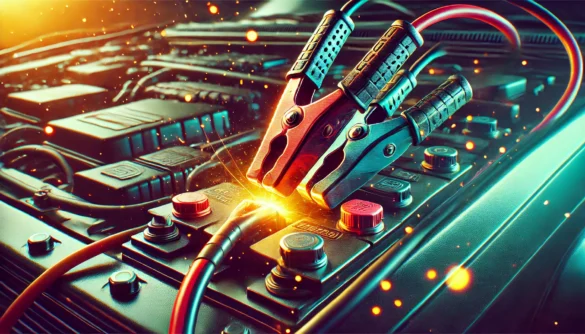Finding yourself with a dead car battery can be frustrating, especially when you’re in a rush. Knowing how to jumpstart a car safely is an essential skill that can save you time and money. Here’s a detailed, step-by-step guide to ensure you do it correctly and avoid potential hazards.
What You’ll Need
- Jumper cables: Ensure they are in good condition with no exposed wires.
- Another vehicle with a fully charged battery or a portable jump starter.
- Safety gloves and goggles (optional but recommended).
Safety Precautions
- Check for Damage: Inspect the battery for cracks, leaks, or corrosion. If the battery is damaged, do not attempt to jumpstart it.
- Park Safely: Make sure both vehicles are parked on a flat surface, away from traffic. Engage the parking brakes on both cars.
- Turn Everything Off: Ensure all electronics in both vehicles are turned off, including lights, radio, and air conditioning.
Step-by-Step Instructions
1. Position the Vehicles
Park the vehicle with the working battery close enough for the jumper cables to reach, but ensure the cars are not touching each other.
2. Connect the Jumper Cables
- Red Clamp to Dead Battery: Attach one red clamp to the positive (+) terminal of the dead battery.
- Red Clamp to Good Battery: Attach the other red clamp to the positive (+) terminal of the good battery.
- Black Clamp to Good Battery: Attach one black clamp to the negative (-) terminal of the good battery.
- Black Clamp to Ground: Attach the other black clamp to an unpainted metal surface on the dead car, such as a bolt or the engine block. Avoid connecting it to the negative terminal of the dead battery to prevent sparks.
3. Start the Working Vehicle
Turn on the engine of the vehicle with the good battery and let it idle for a few minutes. This allows the dead battery to gain some charge.
4. Start the Dead Vehicle
Attempt to start the car with the dead battery. If it doesn’t start immediately, wait another minute and try again. Avoid cranking the engine for more than 5 seconds at a time to prevent damage.
5. Remove the Jumper Cables
Once the dead car starts, carefully remove the cables in the reverse order:
- Remove the black clamp from the grounded metal surface.
- Remove the black clamp from the negative terminal of the good battery.
- Remove the red clamp from the good battery.
- Remove the red clamp from the dead battery.
6. Keep the Engine Running
Let the revived car run for at least 15-20 minutes to allow the alternator to recharge the battery. Drive it around if possible.
What to Do If Jumpstarting Fails
If the car doesn’t start after several attempts, the battery may be completely dead, or there could be an issue with the alternator or starter. In this case:
- Check the connections and ensure the clamps are secure.
- Consider using a portable jump starter as an alternative.
- Call for roadside assistance or a professional mechanic.
Additional Tips
- Avoid Overloading the Battery: Disconnect any unnecessary electronics during the process.
- Carry a Portable Jump Starter: These devices are compact and can eliminate the need for a second vehicle.
- Regular Maintenance: Check your battery’s health periodically to avoid unexpected failures.
Conclusion
Jumpstarting a car safely is a straightforward process if you follow these steps and precautions. Keep a set of jumper cables in your vehicle and familiarize yourself with their use. This knowledge can be a lifesaver in emergencies and help you assist others in need. Always prioritize safety and consult a professional if you’re unsure about any step.
By following this guide, you can confidently tackle a dead battery and get back on the road in no time.

